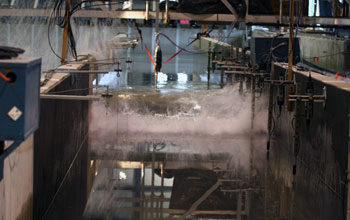Multimedia Gallery
Tsunamis Research on Coastal Communities/
Infrastructure (Image 2)
In this experiment, conducted at the O.H. Hinsdale Wave Research Laboratory at Oregon State University, a tsunami wave breaks on a reef crest and begins to propagate over the flat reef, which has some initial standing water. Acoustic Doppler velocimeters (ADVs), which are used to measure fluid velocity, can be seen on the right side of the flume. Wire resistance wave gauges, used to measure water depths, can be seen on the left side.
Tsunamis pose a significant threat to coastal communities and infrastructure throughout the world. In many cases, horizontal evacuation is not possible due to very short warning times or the large number of people to be evacuated. It is essential that existing buildings--or new emergency centers--be evaluated or designed for vertical evacuation. However, there has been a lack of research on the effects of tsunami waves on coastal infrastructure such as buildings, bridges and harbor facilities, and design guidelines are lacking.
Researchers conducted experiments to help better understand 1) how tsunamis propagate over shallow reefs and onto shore, and 2) the forces waves put on these on-shore structures when they hit them. The results from the experiments will help researchers provide guidance in designing tsunami-resilient structures.
This image is based on work supported by the National Science Foundation's George E. Brown Jr. Network for Earthquake Engineering Simulation (NEES) program (grants CMMI 05-30759 and CMS 04-02490). (Date of Image: 2007) [Image 2 of 3 related images. See Image 3.]
Credit: R. Riggs, University of Hawaii
Images and other media in the National Science Foundation Multimedia Gallery are available for use in print and electronic material by NSF employees, members of the media, university staff, teachers and the general public. All media in the gallery are intended for personal, educational and nonprofit/non-commercial use only.
Images credited to the National Science Foundation, a federal agency, are in the public domain. The images were created by employees of the United States Government as part of their official duties or prepared by contractors as "works for hire" for NSF. You may freely use NSF-credited images and, at your discretion, credit NSF with a "Courtesy: National Science Foundation" notation.
Additional information about general usage can be found in Conditions.
Also Available:
Download the high-resolution JPG version of the image. (3.3 MB)
Use your mouse to right-click (Mac users may need to Ctrl-click) the link above and choose the option that will save the file or target to your computer.



